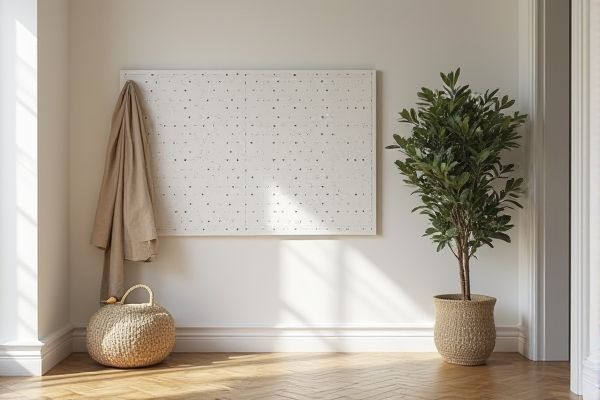
A hall tree is a multifunctional piece of furniture combining hooks, storage benches, and sometimes mirrors, offering a stylish and organized entryway solution, while a peg board is a versatile wall-mounted system primarily designed for hanging items in a customizable arrangement. Discover how choosing the right option can enhance Your home's functionality by reading the rest of the article.
Table of Comparison
| Feature | Hall Tree | Peg Board |
|---|---|---|
| Primary Use | Entryway furniture for hanging coats, storing shoes, and seating | Wall-mounted storage for hanging items with pegs or hooks |
| Design | Freestanding with shelves, hooks, and often a bench | Flat board with removable pegs/hooks, customizable layout |
| Storage Capacity | Higher--includes hooks, shelves, baskets, bench storage | Moderate--limited to items hung on pegs |
| Installation | No wall installation needed; freestanding | Wall-mounted, requires screws and anchors |
| Space Efficiency | Takes more floor space | Maximizes vertical wall space |
| Mobility | Easy to relocate within a room | Permanent once installed |
| Style | Often traditional, rustic, or farmhouse styles | Modern and minimalist appearance |
| Cost | Generally higher price range | More affordable |
Introduction to Hall Trees and Peg Boards
Hall trees combine storage solutions such as benches, hooks, and shelves to organize entryways while offering seating and coat-hanging functionality. Peg boards provide a versatile, customizable surface with evenly spaced holes designed to hold various hooks and accessories for organizing tools or household items. Both serve distinct organizational needs, with hall trees emphasizing entryway decor and seating, and peg boards focusing on flexible wall storage and tool management.
What Is a Hall Tree?
A hall tree is a versatile piece of furniture designed to organize entryway essentials like coats, hats, and shoes, often featuring hooks, shelves, and sometimes a bench. Unlike a simple peg board, a hall tree combines storage with seating, maximizing functionality in compact spaces. Your home gains both style and practicality with a hall tree, making it ideal for keeping clutter controlled.
What Is a Peg Board?
A peg board is a versatile wall-mounted organizing system featuring evenly spaced holes designed to hold hooks, pegs, or shelves for hanging tools, accessories, or household items. Unlike a hall tree, which typically includes seating, storage compartments, and a frame for coats and hats, a peg board emphasizes customizable vertical storage for efficient space utilization. Peg boards are commonly used in workshops, garages, and kitchens to keep frequently used items within easy reach and maintain order.
Key Features of Hall Trees
Hall trees combine seating, storage, and hooks in a single unit, making them ideal for entryways to organize coats, hats, and shoes efficiently. Typically crafted from wood or metal, hall trees often feature built-in benches with cubbies, drawers, or shelves for added storage convenience. The design emphasizes multifunctionality and durability, distinguishing hall trees from simpler peg boards that primarily serve as wall-mounted hook systems without seating or enclosed compartments.
Key Features of Peg Boards
Peg boards offer a versatile and space-saving storage solution with customizable hooks and accessories for organizing tools, kitchen utensils, or craft supplies. Their perforated design allows easy rearrangement and efficient use of vertical space, making them ideal for both workshop and home environments. Peg boards often feature durable materials like metal or hardboard, providing long-lasting support for various hanging items.
Hall Tree vs Peg Board: Space Efficiency
Hall trees offer multifunctional storage by combining seating, coat hooks, and often shelves, making them ideal for maximizing vertical space in entryways. Peg boards provide customizable, flexible storage and organization options for small items using various hooks and accessories, which excel in compact or narrow areas. Compared to peg boards, hall trees typically require more floor space but deliver higher capacity and convenience for outerwear and daily essentials.
Storage Capacity Comparison
A hall tree offers greater storage capacity than a peg board by combining hooks, shelves, and often a bench with drawers or cubbies, providing ample space for coats, shoes, and accessories. Peg boards primarily serve as versatile wall storage with hooks and small shelves but lack the integrated seating or substantial compartmentalization found in hall trees. When maximizing your entryway storage, a hall tree is more efficient for organizing multiple items in a compact area.
Style and Aesthetic Differences
Hall trees offer a classic, multifunctional design often featuring seating, storage, and intricate woodwork that adds an elegant, traditional touch to entryways. Peg boards present a minimalist, modern aesthetic characterized by clean lines and customizable peg arrangements, ideal for contemporary or industrial decor. Your choice depends on whether you prefer the timeless charm of a hall tree or the sleek versatility of a peg board to complement your space.
Installation and Maintenance
Hall trees typically require floor space and involve moderate installation, often secured with screws or anchors for stability, making them more permanent fixtures. Peg boards are wall-mounted with simple screw or anchor placements, offering flexible positioning and easier installation suited for various wall types. Maintenance for hall trees involves regular dusting and occasional tightening of hardware, while peg boards require minimal upkeep, primarily wiping down surfaces and ensuring hooks remain securely fastened.
Which Is Best for Your Entryway?
A hall tree offers a multifunctional entryway solution with hooks, a bench, and storage compartments, making it ideal for organizing coats, shoes, and accessories in one compact piece. In contrast, a pegboard provides versatile wall-mounted storage that maximizes vertical space and adapts easily to changing needs with customizable hooks and shelves. Selecting the best option depends on available space and organizational preferences, with hall trees suited for larger entryways and pegboards excelling in smaller or minimalist areas.
 homyna.com
homyna.com